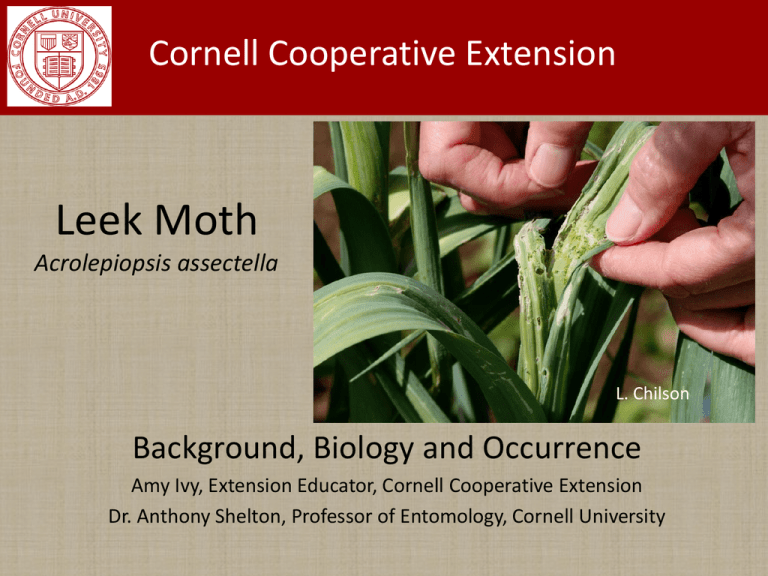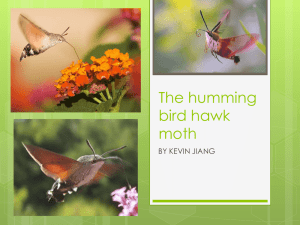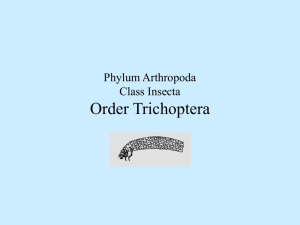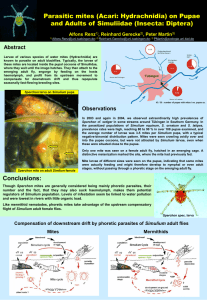Powerpoint (12MB File) - Leek Moth: Information Center for the US
advertisement

Cornell Cooperative Extension Leek Moth Acrolepiopsis assectella L. Chilson Background, Biology and Occurrence Amy Ivy, Extension Educator, Cornell Cooperative Extension Dr. Anthony Shelton, Professor of Entomology, Cornell University Host Crops • All members of the Allium (onion) family – – – – – – – Onions Leeks Garlic Chives Shallots Wild alliums About 60 species of Allium in the use, wild and cultivated Damage • • • • Feeds on foliage Reduces yield Can lessen storage life Multiple generations increase in damage Where did leek moth come from? • Well established in Asia, Africa and Europe for centuries • 1993 - came from Europe to Canada (eastern Ontario) • 2001-02 localized sightings • 2007 more sightings in southern Ontario How do they spread? • 2009 - first sighting in the continental US in Plattsburgh, NY (Clinton County) • 2010 - confirmed in St. Lawrence County • 2011 – more sites found in St. Lawrence County, one new site in Clinton County, NY • Adults can fly 100-200 meters • Also carried on weather fronts even farther • Onion starter plants can be infested and transported Life Cycles - Generations • Late April - early May – overwintered adults emerge, lay eggs for up to 28 days • Mid-late June – first generation adults emerge • Early August – second generation adults emerge (possibly) Depending on the weather and temperatures: Life Cycle - Overwintering • Adults overwinter in protected locations – • Buildings, hedges, plant debris Moths don’t fly more than 100-200 meters – • 0.25 inch But are small and carried on the wind Moths fly when average daily temperature is ~50° F • • Mate within 24 hours of emergence Average adult lifespan = 23 days Adult Identification • Adult moths • Reddish brown to gray in color • White triangle shaped spot on folded wings • Nocturnal 0.25 inch Copyright Robin Barfoot Life Cycle - Eggs • Eggs are laid on lower leaf surfaces • Tiny and very hard to see • Laid when temperatures are 50-55 ° F • Hatch in 4-11 days Life Cycle - Larvae • Larvae are slender, yellow-green • First instar hard to see • Grow to ~ 1 inch long in final stage • 8 tiny dark spots on each body segment • 11-23 days as larvae, depending on temperature Life Cycle – Pupae • Look for pupae on nearby leaves and structures • 12-21 days as pupae • Adults emerge and live ~ 23 days How to find Leek Moth on onions • Look for windowpaning on onion leaves • Split leaf open and look for frass and debris • Larva may or may not be present – debris is telltale evidence Heavily infested onion planting How to find Leek Moth on garlic • In June, look first at scapes if hardneck type garlic • Then look at newest leaves • Unfold leaves and look for debris and larvae Chewed debris and frass Garlic at early stage of infestation How to find Leek Moth on leeks • Look at newest leaves • Look for windowpaning, holes, debris L. Chilson Windowpaning and larvae (in circle) on leek L. Chilson Leek Moth Look-alike Damage: Salt Marsh Caterpillar • Windowpane type damage, but on outside of onion leaves • Caterpillar is hairy and more robust than leek moth • Found on onions and leeks in 2011 Salt marsh caterpillars on onion Leek Moth Look-alike Damage: Thrips • Many tiny insects • Individual feeding damage gives a more speckled look than windowpanes C. Hoepting C. Hoepting Leek Moth Look-alike Damage: Slugs • Feeding damage on the outside of onion leaves • Favored by damp weather • Look for slugs at evening or early morning • Use shallow dishes of beer to trap slugs Leek Moth Look-alike Damage: Botrytis Leaf Blight on Onions • White patches on leaves • Split leaves open, clean inside – no frass or debris • Favored by wet weather • Purple blotch disease often found with botrytis (favored by similar conditions) C. Hoepting Leek Moth Look-alike Damage: European Corn Borer in garlic • Larvae tunnel right into garlic stalk, into newest growth • Late corn planting in 2011 forced ECB to find other hosts • Larger hole bored, larger larvae, with dark head Management - Prevention • Know your source – Check packs of onion seedlings carefully – But even with clean plants, adults can fly or be blown in • Rotate to a new location Management - Prevention • Use rowcover immediately after planting in new location to prevent egg laying • Moths are nocturnal, so rowcover can be removed during the day for weeding and replaced in the evening Management - Control • Garlic – diligent removal of damaged scapes may help by destroying larvae there • Sprays – 5 have a 2ee special label in 2011 • Efficacy trials underway in lab • Field trials are needed Management - Control • Organic sprays don’t move through tissue well, most need to contact larvae directly • Larvae are protected inside onion leaves, or inside folded garlic and leek leaves • Conventional sprays can be effective Management - Horizons • Natural enemies • In Europe, a number of predators, parasites and pathogens are known to attack the larvae and pupae of the leek moth • Currently, researchers in Canada are evaluating North American species that may offer control, as well as European biological control candidates, for release in Canada Cornell Cooperative Extension For More Information Dr. Anthony Shelton - Professor, Dept of Entomology, Cornell University ams5@cornell.edu Daniel Olmstead – Research Support Specialist, Dept of Entomology, Cornell University dlo6@cornell.edu Amy Ivy – Cornell Cooperative Extension Educator , Plattsburgh, NY adi2@cornell.edu http://web.entomology.cornell.edu/shelton/leek-moth/










